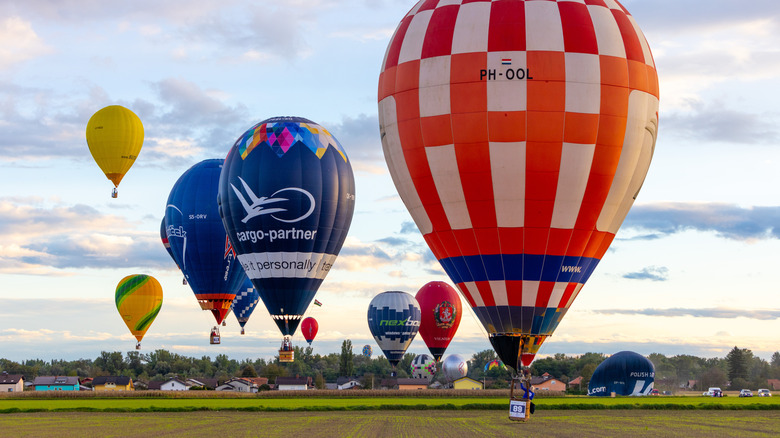What Stops A Hot Air Balloon From Just Landing Anywhere?
With their colorful designs and a breathtaking view below the basket, hot air balloons have become a romantic and exciting way to explore the skies — and more people are taking rides than ever before. Depending on the hot air balloon company, you can reach anywhere from 500 to 1,000 feet into the air and remain up there for an hour, gazing over the fields below. While it may seem like a carefree journey, there are a lot of things for pilots to consider when floating back down.
Similar to helicopters, hot air balloons can't land anywhere they want. Pilots must consider the terrain and local laws when preparing to descend. Hot air balloon excursions are considered to be generally safe, and accidents are rare, but part of that is having a skilled and certified pilot who knows exactly how to guide the balloon and its passengers back to the ground after a ride.
Hot air balloons need the perfect landing spot
Pilots start scouting out a spot 20 minutes before descending, maneuvering the balloon, and releasing hot air as they approach the target. But how do pilots pick the right spot? The perfect landing spot for a hot air balloon is flat, stable terrain with no obstacles. The Federal Aviation Administration (FAA) advises against city streets, highways, and other busy areas. Fields should have plenty of open space with no obstructions, like power lines, in the way.
Wind is one of the biggest factors in determining where a balloon can land. The amount of wind impacts how the pilot lands the hot air balloon, as some techniques require a wider area of open air with a clear path. While hot air balloons have no built-in steering component, pilots can change the balloon's altitude and direction to ensure a safe landing — similar to how planes can use the wind to glide in a controlled manner.
A common technique is known as the "stairstep approach," which has the pilot descending diagonally and then horizontally in a pattern similar to a staircase — hence the name. This takes up a lot of room rather than going straight downward, which makes a large, empty space even more necessary.
Not all landing spots are legal
In addition to the type of space and terrain, hot air balloon pilots also have to consider local laws when landing. These can vary by state, county, or even individual property, so pilots must learn local laws to find an appropriate landing spot. They can also reach out to private property owners to get permission to use the land if it's perfect for a safe descent.
For example, San Francisco prohibits hot air balloons, hang gliders, and other "apparatus of aviation" from launching or landing in any park without permission from the Recreation and Park Department. No balloons with a diameter of over 6 feet are even allowed in the parks without asking first.
Local law in St. Pete Beach, Florida, states that it's unlawful for any area of land or water within the city limits to be used as an airport. However, a hot air balloon pilot may submit a written application to the city manager for approval to operate within the city, but this must be done every time the hot air balloon is used. In short, it's very important to know the local laws before you land because you never know the strange laws you may end up dealing with.


